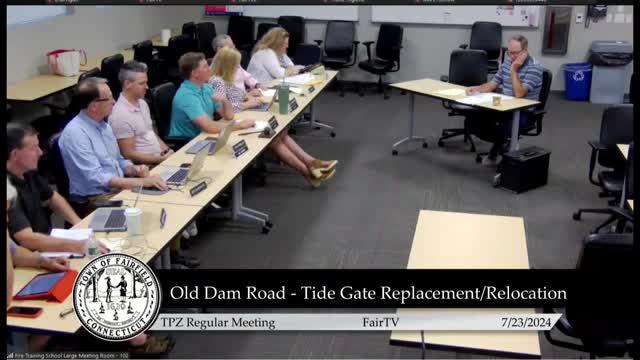Tide gate project aims to protect vital salt marsh ecosystem
July 24, 2024 | Fairfield, Fairfield, Connecticut

This article was created by AI summarizing key points discussed. AI makes mistakes, so for full details and context, please refer to the video of the full meeting. Please report any errors so we can fix them. Report an error »

In a recent government meeting, officials discussed a significant project involving the replacement of aging tide gates and outfall pipes that play a crucial role in maintaining the health of local tidal marshes. The existing infrastructure, installed in 1982, is essential for promoting the growth of tidal marsh grasses and supporting various species while preventing the spread of invasive phragmites, which pose a fire hazard.
The proposed project includes the installation of five new outfall pipes, featuring three self-regulating tide gates and two flapper-type tide gates. This upgrade aims to enhance tidal flushing and increase the capacity for stormwater discharge into Long Island Sound. The project has received approval from the Department of Energy and Environmental Protection (DEEP) for necessary structures and dredging permits, confirming its alignment with coastal resource policies.
During the meeting, concerns were raised about the potential impact of the new tide gates on the marsh's water levels. Specifically, there is a risk that the accelerated discharge of saltwater could lead to reduced soak time in the marsh, adversely affecting the natural salt marsh ecosystem. Officials noted that this issue had previously been observed in Ash Creek, where similar infrastructure changes resulted in drier conditions that favored invasive species over native marsh plants.
To mitigate these risks, a recommendation was made to consult with Mr. Stanke, the inventor of the tide gates, for guidance on managing the new installations. The aim is to ensure that the marsh retains adequate wet conditions and does not dry out too quickly, which could lead to detrimental ecological changes.
The meeting concluded with a motion to approve the project, contingent upon adherence to specific management recommendations to protect the marsh's health. The discussions highlighted the delicate balance between infrastructure improvements and environmental stewardship, underscoring the importance of expert consultation in managing coastal resources effectively.
The proposed project includes the installation of five new outfall pipes, featuring three self-regulating tide gates and two flapper-type tide gates. This upgrade aims to enhance tidal flushing and increase the capacity for stormwater discharge into Long Island Sound. The project has received approval from the Department of Energy and Environmental Protection (DEEP) for necessary structures and dredging permits, confirming its alignment with coastal resource policies.
During the meeting, concerns were raised about the potential impact of the new tide gates on the marsh's water levels. Specifically, there is a risk that the accelerated discharge of saltwater could lead to reduced soak time in the marsh, adversely affecting the natural salt marsh ecosystem. Officials noted that this issue had previously been observed in Ash Creek, where similar infrastructure changes resulted in drier conditions that favored invasive species over native marsh plants.
To mitigate these risks, a recommendation was made to consult with Mr. Stanke, the inventor of the tide gates, for guidance on managing the new installations. The aim is to ensure that the marsh retains adequate wet conditions and does not dry out too quickly, which could lead to detrimental ecological changes.
The meeting concluded with a motion to approve the project, contingent upon adherence to specific management recommendations to protect the marsh's health. The discussions highlighted the delicate balance between infrastructure improvements and environmental stewardship, underscoring the importance of expert consultation in managing coastal resources effectively.
View full meeting
This article is based on a recent meeting—watch the full video and explore the complete transcript for deeper insights into the discussion.
View full meeting
